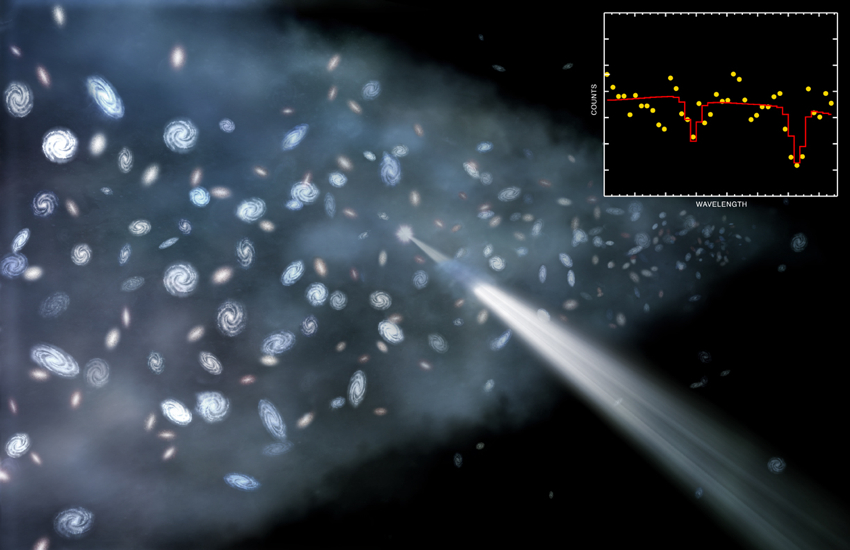
 Credit: Illustration: NASA/CXC/M.Weiss; Spectrum: NASA/CXC/Univ. of California Irvine/T. Fang et al.
Credit: Illustration: NASA/CXC/M.Weiss; Spectrum: NASA/CXC/Univ. of California Irvine/T. Fang et al.
Missing No More?
There's lots of stuff missing from our friendly Universe. We miss the light from "dark matter", that stuff that exerts gravitational force but that is nearly impossible to detect otherwise. It's also hard sometimes to keep track of stuff we know is there. For example, when we try to count up all the usual, familiar stuff like protons, neutrons, and electrons, we find an embarrassment: in the well-studied "local" Universe, we can find only about half the amount of normal matter that we know exists in the Universe. Where is it? Astronomers believe that about half the normal matter is not bound up in stars, planets or galaxies, but instead forms a thin, tenuous web of material in the vast space between galaxies. This material goes by the fanciful name of the "WHIM", which stands for Warm Hot Intergalactic Medium, and is shown in an artist conception above. The WHIM is extremely difficult to detect directly, since it is so tenous, and since it exists (we think) at a fairly high temperature. But enterprising astronomers have performed a unique experiment using both the Chandra and XMM-Newton X-ray observatories to try to detect the WHIM by detecting its absorption signature in the X-ray light of a distant active galaxy. The idea is that as the X-ray emission from the background active galaxy traverses the WHIM, atoms in the WHIM will absorb a portion of the light, allowing astronomers to detect the WHIM directly and to constrain how much WHIM there might be. The inset shows the X-ray brightness of the active galaxy vs. X-ray wavelength. The two narrow drops in brightness represent absorption by WHIM-sical oxygen atoms.
Published: May 17, 2010
<
HEA Dictionary ● Archive
● Search HEAPOW
● Other Languages
● HEAPOW on Facebook
● Download all Images
● Education ● HEAD
>

Each week the HEASARC
brings you new, exciting and beautiful images from X-ray and Gamma ray
astronomy. Check back each week and be sure to check out the HEAPOW archive!
Page Author: Dr. Michael F. Corcoran
Last modified Monday, 26-Feb-2024 17:36:54 EST


